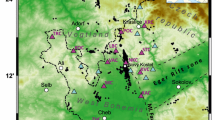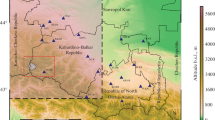Abstract
This paper presents the basic characteristics of the 2011 West Bohemia/Vogtland earthquake swarm and compares it with the swarms in 2000 and 2008. All these swarms occurred in the Nový Kostel focal zone. Up to 25,000 M L ≤3.7 events with depths between 6 and 10 km were detected in the 2011 swarm. Utilizing WEBNET data, we analysed the cumulative seismic moment, magnitude-frequency and interevent time distributions, space-time distribution of foci and typical focal mechanisms. For this purpose, we improved the formula for estimating the local magnitude M L used by WEBNET. The 2011 swarm exhibited much higher rapidity than the swarms of 2000 and 2008. The magnitude-frequency distributions of all the three swarms are similar, having the b-value close to 1.0. However, the events of higher magnitudes, roughly M L ∼3.0+, depart markedly from the general trend of the weaker events. The probability density functions of the interevent times of all the swarms comply with power law ∝T −1.4, which points to Omori law-like mainshock-aftershock activity. All swarms exhibit a pronounced focal migration; however, no regularity was found. The spatial distribution of the 2011 foci indicates two active fault segments which differ from the segment triggered in the swarms of 2000 and 2008. Furthermore, we analysed the spatial distribution of the mini-swarm of 2013 and found that it complements the swarm of 2011. The prevailing focal mechanisms in the 2011 swarm are of both oblique-normal and oblique-thrust types and correspond closely to the geometry of the activated fault segments. Our analyses indicate that the Nový Kostel area is more complex than was believed to be.







Similar content being viewed by others
References
Babuška V, Plomerová J, Fischer T (2007) Intraplate seismicity in the western Bohemian Massif (central Europe): a possible correlation with a paleoplate junction. J Geodyn 44(3–5):149–159. doi:10.1016/j.jog.2007.02.004
Bankwitz P, Schneider G, Kämpf H, Bankwitz E (2003) Structural characteristics of epicentral areas in Central Europe: Study case Cheb Basin (Czech Republic). J Geodyn 35(1–2):5–32. doi:10.1016/S0264-3707(02)00051-0
Bouchaala F, Vavryčuk V, Fischer T (2013) Accuracy of the master-event and double-difference locations: Synthetic tests and application to seismicity in West Bohemia, Czech Republic. J Seismol 17(3):841–859. doi:10.1007/s10950-013-9357-4
Doubravová J, Horálek J (2013) New interactive software for seismic data processing. Technical Computing Prague 2013 21st Annual Conference Proceedings
Fischer T (2003) Automatic location of swarm earthquakes from local network data. Stud Geophys Geod 47(1):83–98. doi:10.1023/A:1022251605990
Fischer T, Horálek J (2000) Refined locations of the swarm earthquakes in the Nový Kostel focal zone and spatial distribution of the January 1997 swarm in Western Bohemia, Czech Republic. Stud Geophys Geod 44(2):210–226. doi:10.1023/A:1022162826079
Fischer T, Horálek J (2003) Space-time distribution of earthquake swarms in the principal focal zone of the NW Bohemia/Vogtland seismoactive region: Period 1985–2001. J Geodyn 35(1–2):125–144. doi:10.1016/S0264-3707(02)00058-3
Fischer T, Horálek J (2005) Slip-generated patterns of swarm microearthquakes from West Bohemia/Vogtland (central Europe): Evidence of their triggering mechanism? J Geophys Res 110(B05S21). doi:10.1029/2004JB003363
Fischer T, Horálek J, Michálek J, Boušková A (2010) The 2008 West Bohemia earthquake swarm in the light of the WEBNET network. J Seismol 14(4):665–682. doi:10.1007/s10950-010-9189-4
Fischer T, Horálek J, Hrubcová P, Vavryčuk V, Bräuer K, Kämpf H (2014) Intra-continental earthquake swarms in West-Bohemia and Vogtland: a review. Tectonophysics 611:1–27. doi:10.1016/j.tecto.2013.11.001
Hainzl S (2004) Seismicity patterns of earthquake swarms due to fluid intrusion and stress triggering. Geophys J Int 159(3):1090–1096. doi:10.1111/j.1365-246X.2004.02463.x
Hainzl S, Fischer T (2002) Indications for a successively triggered rupture growth underlying the 2000 earthquake swarm in Vogtland/NW Bohemia. J Geophys Res 107(B12,2338):1–9. doi:10.1029/2002JB001865
Hainzl S, Ogata Y (2005) Detecting fluid signals in seismicity data through statistical earthquake modeling. J Geophys Res 110(No.B5, B05S07). doi:10.1029/2004JB003247
Horálek J, Fischer T (2010) Intraplate earthquake swarms in West Bohemia/Vogtland (Central Europe). Jökull 60:67–87
Horálek J, Šílený J (2013) Source mechanisms of the 2000 earthquake swarm in the West Bohemia/Vogtland region (Central Europe). Geophys J Int 194(2):979–999. doi:10.1093/gji/ggt138
Horálek J, Fischer T, Boušková A, Jedlička P (2000) The Western Bohemia/Vogtland region in the light of the WEBNET network. Stud Geophys Geod 44(2):107–125. doi:10.1023/A:1022198406514
Horálek J, Šílený J, Fischer T (2002) Moment tensors of the January 1997 earthquake swarm in NW Bohemia (Czech Republic): Double-couple vs. non-double-couple events. Tectonophysics 356:65–85. doi:10.1016/S0040-1951(02)00377-3
Horálek J, Fischer T, Boušková A, Michálek J, Hrubcová P (2009) The West Bohemian 2008-earthquake swarm: when, where, what size and data. Stud Geophys Geod 53(3):351–358. doi:10.1007/s11200-009-0024-8
Lomax A, Virieux J, Volant P, Berge C (2000) Probabilistic earthquake location in 3D and layered models: Introduction of a Metropolis-Gibbs method and comparison with linear locations. In: Thurber CH, Rabinowitz N (eds) Advances in seismic event location. Kluwer, Amsterdam, pp 101–134
Lomax A, Michelini A, Curtis A (2009) Earthquake location, direct, global-search methods. In: Meyers RA (ed) Encycl complex Syst Sci, Part 5. doi:10.1007/978-0-387-30440-3. Springer, New York, pp 2449–2473
Málek J, Horálek J, Janský J (2005) One-dimensional qP-wave velocity model of the upper crust for the West Bohemia/Vogtland earthquake swarm region. Stud Geophys Geod 49(4):501–524. doi:10.1007/s11200-005-0024-2
Mrlina J, Kämpf H, Kroner C, Mingram J, Stebich M, Brauer A, Geissler W H, Kallmeyer J, Matthes H, Seidl M (2009) Discovery of the first quaternary maar in the Bohemian Massif, Central Europe, based on combined geophysical and geological surveys. J Volcanol Geotherm Res 182(1–2):97–112. doi:10.1016/j.jvolgeores.2009.01.027
Neunhöfer H, Hemmann A (2005) Earthquake swarms in the Vogtland/Western Bohemia region: Spatial distribution and magnitude-frequency distribution as an indication of the genesis of swarms? J Geodyn 39(4):361–385. doi:10.1016/j.jog.2005.01.004
Parotidis M, Rothert E, Shapiro S A (2003) Pore-pressure diffusion: a possible triggering mechanism for the earthquake swarms 2000 in Vogtland/NW-Bohemia, central Europe. Geophys Res Lett 30(20):2075. doi:10.1029/2003GL018110
Utsu T (1971) Aftershocks and earthquake statistics (III) - Analyses of the distribution of earthquakes in magnitude,time and space with special consideration to clustering characteristics of earthquake occurrence (1). Journal of the Faculty of Science, Hokkaido University Series 7, Geophysics 3(5):379–441. http://hdl.handle.net/2115/8688
Utsu T, Ogata Y, Matsu’ura R S (1995) The centenary of the Omori formula for a decay law of aftershock activity. J Phys Earth 43:1–33. doi:10.4294/jpe1952.43.1
Vavryčuk V (2001) Inversion for parameters of tensile earthquakes. J Geophys Res 106(B8):16,339–16,355. doi:10.1029/2001JB000372
Vavryčuk V (2002) Non-double-couple earthquakes of 1997 January in West Bohemia, Czech Republic: Evidence of tensile faulting. Geophys J Int 149(2):364–373. doi:10.1046/j.1365-246X.2002.01654.x
Vavryčuk V (2011) Principal earthquakes: Theory and observations from the 2008 West Bohemia swarm. Earth Planet Sci Lett 305(3–4):290–296. doi:10.1016/j.epsl.2011.03.002
Vavryčuk V, Bouchaala F, Fischer T (2013) High-resolution fault image from accurate locations and focal mechanisms of the 2008 swarm earthquakes in West Bohemia, Czech Republic. Tectonophysics 590:189–195. doi:10.1016/j.tecto.2013.01.025
Švancara J, Havíř J, Conrad W (2008) Derived gravity field of the seismogenic upper crust of SE Germany and West Bohemia and its comparison with seismicity. Stud Geophys Geod 52(4):567–588. doi:10.1007/s11200-008-0038-7
Waldhauser F (2001) hypoDD: A computer program to compute double-difference hypocenter locations. US Geol Surv Open File Rep 01–113:1–25
Waldhauser F, Ellsworth W (2000) A double-difference earthquake location algorithm: Method and application to the northern Hayward fault, California. Bull Seismol Soc Am 90(6):1353–1368. doi:10.1785/0120000006
Wiemer S, Wyss M (2000) Minimum magnitude of completeness in earthquake catalogs: Examples from Alaska, the western United States, and Japan. Bull Seismol Soc Am 90(4):859–869. doi:10.1785/0119990114
Acknowledgments
Our special thanks belong to our colleagues Jana Doubravová and Jakub Klicpera for carefully handling the WEBNET data. We also wish to thank Alena Boušková and Martin Labuta for primary processing of the WEBNET seismograms. Tomáš Fischer is in our debt for his help with calibrations of the WEBNET magnitudes. Editor Thomas Braun devoted careful attention to this paper for which we are grateful. The two anonymous reviewers provided valuable suggestions that helped us substantially to improve the paper. The work was accomplished within the Grant Project P210–12–2336 of the Grant Agency of the Czech Republic, “Earthquake swarms and their triggering mechanisms in diverse tectonic environments (Bohemian Massif, Mid-Atlantic Ridge, Western Alps).” The monitoring system WEBNET providing earthquake data received considerable support from the Ministry of Education, Youth and Sport of the Czech Republic (Project LM201000).
Author information
Authors and Affiliations
Corresponding author
Rights and permissions
About this article
Cite this article
Čermáková, H., Horálek, J. The 2011 West Bohemia (Central Europe) earthquake swarm compared with the previous swarms of 2000 and 2008. J Seismol 19, 899–913 (2015). https://doi.org/10.1007/s10950-015-9502-3
Received:
Accepted:
Published:
Issue Date:
DOI: https://doi.org/10.1007/s10950-015-9502-3




